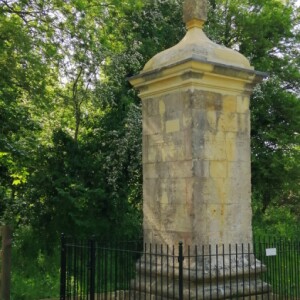Blue
My three favourite village names in our area - just because they sound so mellifluous - are Chastleton, Evenlode and Adlestrop. They are close to one another, in a triangle with sides of about 3km, spanning the Oxfordshire-Gloucestershire border. They are all in the beautiful valley of the river Evenlode, which rises a little further north in Moreton in Marsh. The village name was not applied to the river until the late 1800s - prior to that it was the river Blade, which gave it's name to Bladon, where Winston Churchill is buried
Evenlode village switched counties in a local government reorganisation in the 1930s. It is now in Gloucestershire but was formerly an isolated island of Worcestershire. This turned the nearby Four Shire Stone into a three-shire stone, but no-one was going to mess with a 3m high, grade II monument from the 18th century (which in turn replaced a much older one), so the stone still claims alleigance to Worcestershire on one of its sides
Chastleton is dominated by Chastleton House, a superb Jacobean mansion where some of the scenes from the TV adaptation of Wolf Hall were filmed. The estate was sold by Robert Catesby the year before his involvement in the Gunpowder Plot. Its rebellious Catholic reputation was cemented 40 years later, when the lady of the house drugged roundhead soldiers in order to allow her husband to escape capture. It also claims to be the place where the rules of croquet were first written down
Adlestrop is the one you are most likely to have heard of, because Edward Thomas' rather whimsical poem of that name captured a poignant moment in the beautiful summer of 1914 before the guns began to fire. The poem describes stopping at the station on the Oxford-Hereford "Cotswold Line". The line is still there but the station was demolished in the 1960s. A name board and platform seat were salvaged, and are now part of a bus stop. A small plaque engraved with the poem is attached to the seat. The last stanza reads
"And for that minute a blackbird sang
Close by, and round him, mistier,
Farther and farther, all the birds
Of Oxfordshire and Gloucestershire."
...as they did today when I stopped and read the plaque on my tour of all these places
We have become accustomed to bright yellow fields, but blue ones still provide something of a shock. If you see one, the likeliest candidate is this one - linseed - grown and harvested for its oil-rich seeds, most often for industrial or 'hardware' purposes, but sometimes for human consumption. Linseed is the same plant as flax, but linseed varieties are selected for seed producion, while flax varieties are selected for longer stems, and harvested before fully ripe, to produce fibre for linen and rope. (This is true for the UK, but US, and possibly other parts of the world, use 'linseed' and 'flax' rather more interchangeably)
Other blue crops exist. In our area there are sometimes quite substantial areas of borage - beloved of gardners as a green manure and Pimms drinkers as a floating decoration. On a farm scale, it is also grown for its oil
A very mysterious, and attractive, blue crop appeared in our village a few years ago (with an admixture of some white flowers). A little sleuthing revealed that it was a species of Echium - related to the garden giant that featured in a blip by ceridwen recently, and also to the wildflower Viper's Bugloss, a beekeepers' favourite. The bees loved the field-crop version too, as they do borage. Linseed, surprisingly, offers them nothing, and they completely ignore it



Comments
Sign in or get an account to comment.


